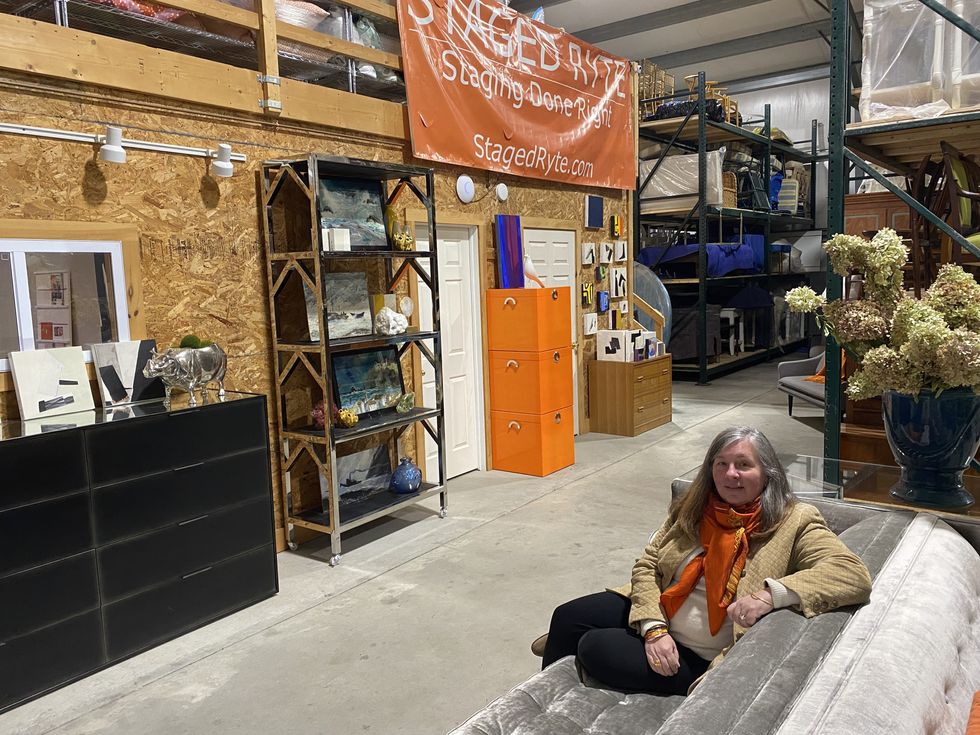
Dawn Trachtenberg invites clients to her 5,000-squre-foot home furnishings warehouse in Ashley Falls, Mass., to help find the right design elements to “stage” or design their home.
Photo by Cynthia Hochswender

It used to be that, to find their dream home, buyers would settle into the car of a real estate agent and drive around looking at properties with “for sale” signs on them.
COVID and the internet have pretty much (although not completely) put an end to that. Most people now search for homes on internet sites such as Zillow, and already have a fairly good idea of what they’re interested in before they contact an agent.
Someone recently said to me that people treat real estate websites in much the same way as they treat dating apps: They look at one or two photos and quickly swipe left or right.
Thus, if you’re trying to sell your house, even in the super hot real estate market of the last year and a half, it is essential to have attractive photos.
Dawn Trachtenberg is the founder and stager-in-chief for Staged Ryte, one of the major staging companies in the Tri-state Region. She says that there are three stages of staging, so to speak: There is fluffing, staging and interior design.
Most people will not (and should not) completely redesign their home before they put it on sale, Trachtenberg notes.
Fluffing by adding flowers, putting crisp linens on beds and tidying up clutter is very helpful, but assumes that a house already looks fairly spruce.
Staging is the middle ground. It’s a relatively new practice for real estate agents. Back in the 1980s and 1990s, owners of new luxury apartment buildings used to create a “model” apartment, often decorated by a famous designer. Potential buyers could step into the model apartment and imagine more easily how dreamy their life could be if they bought a residence in that building.
Staging a house for sale is a similar concept. It requires, for the most part, an unoccupied house, however.
“There are people who do ‘occupied staging,’” Trachtenberg said. “But it’s harder, because you’re integrating new and older furnishings.”
Occupied staging, she explained, is when the owner still lives in the home. Staging it requires using their furniture and accessories, and bringing in updates such as fresh towels, sheets and throw pillows — while predominantly keeping the owner’s furnishings.
And then of course there are the challenges of people and pets living in a house that’s been neatly and perfectly designed. Usually, Trachtenberg said, when she finishes staging a space, she leaves and no one comes into the house again until the photographer is ready for the glamour photo shoot.
In this modern world of real estate sales via photos, Trachtenberg believes that not every corner of a house needs to be documented for the property’s social media posts (although people generally do like to see all the rooms, even if they’re empty, once they start to get serious).
And certainly, Trachtenberg advises, rooms don’t have to be renovated in order to be attractively photographed. The goal is to create a mood for a room that a potential buyer can tap into.
Staged Ryte charges a fee based on the number of rooms that will be furnished; and what kind of furniture and accents will be brought in. Antiques cost more than newer items (Trachtenberg feels that a mix of older and newer items often works best). Generally the furnishings remain in the house until it has sold (which in this market can happen within weeks).
Trachtenberg does not advise sellers to bring in furnishings just for the photo shoot. People want to see the house “from the photos” when they show up at the actual location.
The staging process can be fairly quick with Staged Ryte, thanks to the massive warehouse of furnishings that Trachtenberg recently moved into on Clayton Road in Ashley Falls, Mass. Interior design usually requires weeks (or, more often, months) of waiting for pieces to become available, to be upholstered or finished and to be shipped to a location.
Trachtenberg can also provide interior design services. In those situations, she invites clients into her warehouse to discuss the look for their house; then everything can be trucked over and put in place fairly quickly.
Of course not everyone can move out of their house or afford to have it staged. Trachtenberg shared a few quick tips that can help sellers to at least “fluff up” a house so it can look its best when it’s time for its closeup.
Edit!
“Too much big furniture in a room is not a good thing,” Trachtenberg said. “Two recliners and a huge leather easy-sofa might be comfortable for you and your friends but it won’t help you sell your house.”
Let in the Light
“Take down the window treatments. It lets in more light, which is important.”
The curtains or shades can also dominate the way a room looks and feels. It’s possible but unlikely that a potential buyer will want the same window treatments as the seller.
Depersonalize
“The wall of family photos and awards is too much. The buyer needs to focus on imagining themselves in the space, not be distracted by your diplomas.”
Make it Clean and Fresh
Buy new white towels and new shower curtains. Use fresh new bed linens (and iron out any wrinkles or creases).
Many bestselling house photos show stark white rooms, often with black trim. Trachtenberg feels that might be getting overdone.
“How many people want to live with all-white walls?”
White does look pristine, however. To warm up a white room, Trachtenberg will “use pops of color, eclectic furnishings and decorative pieces, collections of objects on shelves.
“You want to draw people in.”
To learn more about staging and Staged Ryte, go to www.stagedryte.com; email dawn@stagedryte.com ; or call Trachtenberg at 917-543-4590.
NEW BRITAIN — Anthony Labbadia soared to 9th place in the triple jump at the 2025 New England track and field championships Saturday, June 14.
On his first attempt of the event he leaped 44 feet and one inch, qualifying for the finals and setting the new Housatonic Valley Regional High School record. The previous school record of 43 feet eight inches was set by Don Hurlbutt in 1967.

Conditions were rainy for the meet with the grounds crew utilizing a leaf blower to dry the track between events. Labbadia said he had experienced similar weather at the Berkshire League championships in May, and he won the triple jump there, so he was confident.
“It doesn’t bother me,” said Labbadia of the rain, noting he was excited to be back at Willow Brook Park. “Being here makes me jump farther... I just have to make sure I’m thinking about everything without overthinking.”
Labbadia, a rising senior at HVRHS, wrote his capstone on the triple jump. In his research, his mother explained, he studied and broke down the biomechanics of the event.

Two days before the championships, he made a bold change to his jumping approach — switching from a “right, right, left” sequence to “left, left, right” — and it paid off.
“I’m glad I switched my feet,” he said after the result. “I’m happy with my performance.”
Once all the jumpers from Connecticut, Maine, Massachusetts, New Hampshire, Rhode Island and Vermont had finished, Labbadia’s distance held for 9th place.
The triple jump gold medal winner was Amar Skeete, sophomore from Catholic Memorial High School in West Roxbury, Massachusetts, who jumped 48 feet two inches. The 2nd place finisher was Mitch Krasco of Mahar Regional High School in Orange, Massachusetts, with a distance of 46 feet two and a half inches. Jessie Singleton Jr., junior at Bloomfield High School in Connecticut, placed 3rd with a distance of 45 feet ten inches.
Labbadia was the first HVRHS athlete to compete at the New England meet since Sydney Segalla in 2022. Track coach Alan Lovejoy said he cannot recall another HVRHS male athlete qualifying since he became coach in 2009.


The Canaan Pirates pose as champions after defending the Northwest Connecticut District 6 Majors Little League title.
THOMASTON — The Canaan Pirates are champions once more.
In the Northwest Connecticut District 6 Majors Little League title game Friday, June 13, the Pirates defeated Thomaston JRC Transportation by a score of 6-2.
Brody Ohler pitched a two-hitter for Canaan. Milo Ellison relieved him, facing one batter who flew out to right field where Ben Young secured the final out.
Canaan never trailed in the game against top-ranked Thomaston, which lost one game all season prior to the championship. Both JRC losses came from the Pirates, with players aged 10 to 12 from Cornwall, Falls Village, Kent, Norfolk, North Canaan, Salisbury and Sharon.

In the title game at Reeves Field in Thomaston, the Pirates started strong with a lead in the top of the first inning. Ohler singled, then stole second base. Liam Downey brought him home with a single, then Sam Hahn doubled to put runners on second and third. Ellison brought them both home with a triple and the Pirates took a 3-0 lead.
The margin held until the sixth inning when the Pirates extended their lead to 6-0. With J.T. Farr and Bentley King on, Ohler sent a deep shot to center field and rounded the bases for an in-the-park home run.
In the bottom of the sixth, Ohler surrendered two runs before reaching his pitch limit. Ellison stepped in to end the game with some help from Young in right field.
The Pirates piled on Young in the outfield chanting “Benny! Benny!” The two sides shook hands in the spirit of sportsmanship before trophies were awarded.

After winning the District 6 title for the second straight year, Coach Tom Downey said "It feels awesome. Especially this group who worked really hard. Last year we were dominant, this year these guys worked their butts off."
"We definitely earned it," said third baseman Michael Prisco.
Ohler finished with nine strikeouts on the mound, three hits in three at bats, two RBI and a home run. Ellison hit 1-for-2 with two RBI, Liam Downey went 1-for-3 with an RBI, Sam Hahn and J.T. Farr hit 1-for-3 and Sam Hamlin hit 1-for-2.
For Thomaston, Owen H. hit 1-for-2 with two RBI and Lucas K. hit 1-for-2. The pitching trio of Gavin M., Jackson Ether and Brody Conlon combined for 12 strikeouts.

NORTH CANAAN — The Canaan Red Sox ended the season with a thrilling 14-13 win over the Tri-Town Phillies Thursday, June 12.
Canaan trailed for most of the game but kept it close. Ultimately, the Red Sox secured the victory with a final-inning comeback in front of the home crowd at Steve Blass Field.
The Red Sox rejoiced as victors. Reflecting on the season, Coach Nikki Blass stated, “My boys continue to come off the field smiling and doing better than the game before.”
The Red Sox are part of the Northwest Connecticut Steve Blass Little League AAA program, consisting of players aged 9 to 11 from Cornwall, Falls Village, Kent, Norfolk, North Canaan, Salisbury and Sharon. Tri-Town includes players from Goshen, Litchfield, Morris and Warren.

The result June 12 marked the first win of the season for the Red Sox. The night before, Coach Nikki Blass reassured her team with a letter, writing, “You should keep your heads high and know that you are all an asset to this team. Tomorrow we are clearing the slate and we will win.” She continued, “I hear in addition if you put a bat under your bed you get an amazing hit on game day.”
The bat trick paid off and many Red Sox logged hits in the game. “Everyone was on fire,” exclaimed Blass after the game.
Quinn McKniff pitched the majority of the match for Canaan with reliever Myles Shippa taking the mound for the final inning.

Offensively, Blaze Freund logged his first hit of the season. His twin brother Roan scored after sliding head-first into home “Pete Rose-style.” Myles Shippa recorded an RBI double in the game.
The Red Sox gathered beneath the scoreboard for a team photo after the win. With wide smiles and baseballs held high, the players ended another joyous Little League season.
Written by Riley Klein with reporting from Simon Markow.

State Rep. Maria Horn (D-64) was treated for her injuries at Sharon Hospital.
The day after concluding what has been described as a grueling legislative session, State Rep. Maria Horn (D-64) had a running accident, leaving her with a broken pelvis and collarbone among other more minor bruises and abrasions. Despite the injuries, she is in good spirits and recuperating at home, eager to get back on her feet.
Horn said after spending weeks in the assembly hall, she was eager to get some outdoor exercise in, but perhaps pushed a little too hard too soon. She said she was excited to get a run in on the morning of Friday, June 6, but was still exhausted from her time in Hartford and in the final stretch of recovering from a meniscus repair surgery in December.
Before the run, she told friends she was hoping for a “hard reset for [her] health,” she said with a rueful laugh.
Nearing the end of the loop, Horn said her leg was fatigued and gave out, causing her to fall on the pavement. She is grateful for the community members who helped during the ordeal, including an unknown motorist who waited with her until her husband arrived, and the staff at Sharon Hospital who she said were “wonderful.”
She was directed to keep weight off her hip for 4 to 6 weeks, and since her collarbone is also fractured, cannot use crutches so she’s partially wheelchair-bound for the time being. While she’s disappointed to be missing out on the start of hiking, biking and running season, she’s keeping her sights forward and focusing on recovery.
In the meantime, she said she’s grateful for the video and photo updates from her son, who is hiking the Connecticut portion of the Appalachian Trail: “I’m living vicariously through him.”